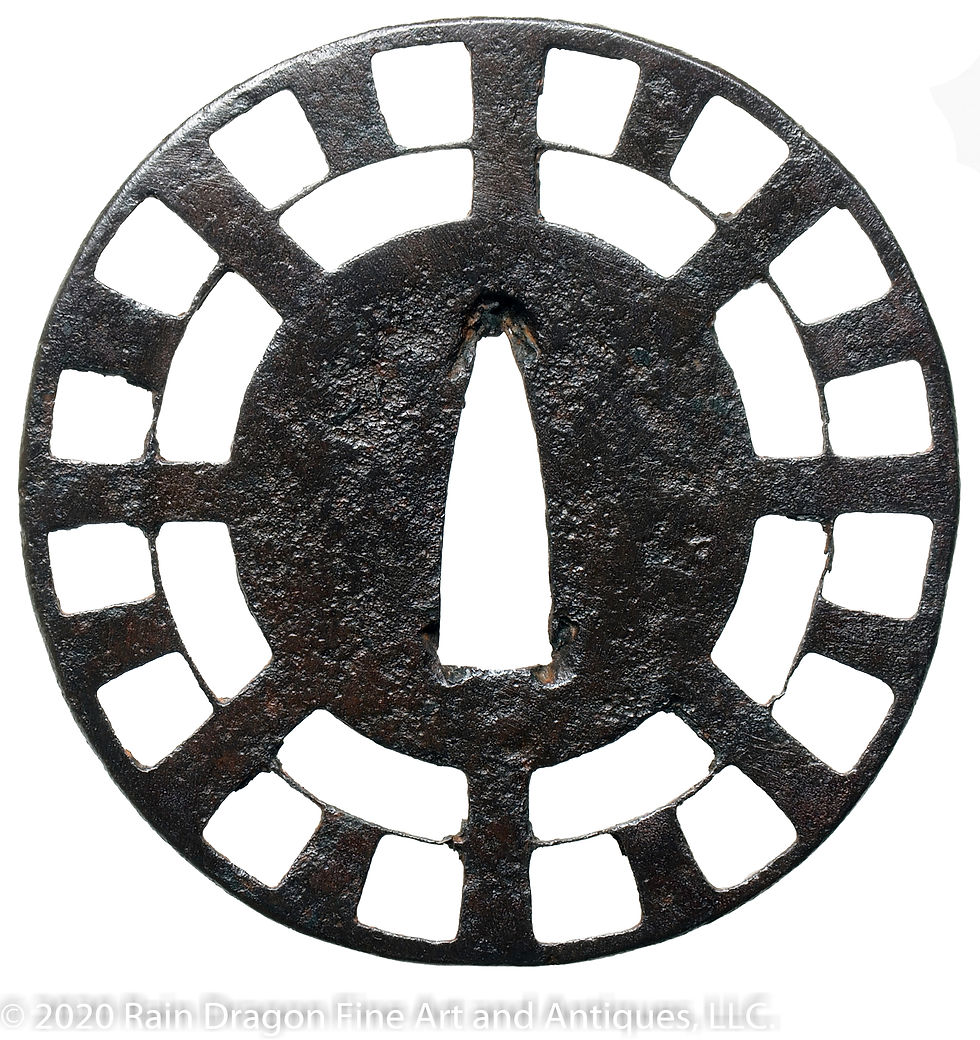(鍔ギャラリー②) Tsuba Gallery #2




Ko-Katchūshi Tsuba (古甲冑師鐔)
Japanese Title: 輪宝図透鐔 (rinbō no zu sukashi tsuba)
Material: Iron (tetsu 鉄)
Age: Middle Muromachi Period (室町時代中期)
Size: 8.0 cm X 8.1 cm, 2.0 mm at rim.
Signature: Mumei (無銘)
Shape: Maru-gata (丸形)
Surface Finish: Tsuchime-ji (槌目地)
Attachment: None
This is sword handguard (tsuba 鐔) made of forged iron (tetsu 鉄). The design done in positive openwork (ji-sukashi 地透) is that of Buddhist holy symbol (rinbō 輪宝). On the reverse side of the tsuba near the center right is an exposed superficial forging flaw that does not impact the functional nature of tsuba adds to great aesthetics. The overall condition of the iron and patina is excellent with just a little bit of damage in places to the delicate openwork. This is commonly seen on tsuba of this advance age. Based upon its overall size, plate construction, and bold simplicity of the openwork design that this tsuba was likely made sometime during middle of the Muromachi Period circa 1400 to 1500 CE. Its early production also explains why such fine work is unsigned (mumei 無銘).
Conventionally in Japanese texts the artisan blacksmiths who made these tsuba were referred to as early armorsmith (Ko-Katchūshi 古甲冑師) based upon how the multilayered plate was forged the technique used to execute the openwork design. Other western Japanese sword fittings experts such as Robert Haynes have used the term (Tanko 鐔工) to describe these type of early iron tsuba via personal communication with Mr. Haynes.
Provenance: Unknown from Japanese Antique Dealer




Higo Kinkō Tsuba (肥後金工鐔)
Japanese Title: 蛸唐草文鐔 (tako karakusa mon tsuba)
Material: Unrefined Copper (yamagane 山銅)
Age: Early Edo Period (江戸時代初期)
Size: 6.9 cm X 7.6 cm, 3.0 mm at the rim
Signature: Mumei (無銘)
Shape: Jūjimokko-gata (十字木瓜形)
Surface Finish: (yakite 焼)
Attachment: NBTHK Hozon Paper
This is a handguard (tsuba 鐔) made for use on a long sword (katana 刀). It is made of unrefined copper (yamagane 山銅). The design carved into the surface of the tsuba is that of a fine and intricate octopus shaped arabesques pattern (tako karakusa-mon 蛸唐草文). The same design is repeated on the reverse side of the tsuba as well. The carved surface has been softened and smoothed using a heating technique (yakite 焼) of the plate. The rim is raised and worked-off at its edge (sukinokoshi-mimi 鋤残耳). The overall shape of the tsuba resembles the cross section of a Japanese melon and the kanji for number ten (jūjimokko-gata 十字木瓜形). This was a common shaped used by many schools of Higo Province (肥後國) during the early Edo Period.
The previous owner attributes this tsuba to be the work of 1st generation Hirata Hikozo (平田彦三) who lived from 1590-1635 CE. Based upon the material and techniques used, more specifically the shape of the rim and the base metal used I think this tsuba was made by an independent but professional artist working in Higo Province during the early Edo Period. Based upon demographic information I can place the production of this tsuba from about 1615 to 1670 CE. An appraisal paper (hozon tōsōgu kanteisho 保存刀装具鑑定書) was issued confirming the tsuba is authentic, of good quality, has artistic merit, and is worthy of historical preservation. The appraisal paper was issued on June 11, 2007. The NBTHK attributed this tsuba to be the work of an independent Higo artist.
References:
-
Works of Hirata and Shimizu by Itō Mitsuru, translated by Markus Sesko, pg. 101 #22, Copyrighted 2007.
-
Higo Kinko Taikan by Sato, Homma, & Kashima, #138 and #143, Copyrighted 1964.
-
Tosogu Classroom Vol. 2 by Fukushi Shigeo, translated by Markus Sesko, Copyrighted 2018.
-
‘鐔鑑賞記’by Zenzai, Internet Blog URL: 鐔鑑賞記 by Zenzai (goo.ne.jp).
-
Handbook of Sword Fittings Related Terms by Markus Sesko, Copyrighted 2011.
-
Higo-tsuba Dandyism Expressed Through Iron by Itō Mitsuru and Itō Sanpei, translated by Markus Sesko, JSSUS, Copyrighted 2014.
-
Japanese Sword Society of United States (JSSUS) Quarterly Journal, Volume 47, No. 2, March-April 2015 ‘Early History of the Hirata School of Higo Province’ by David Stiles, Copyrighted 2015.
Provenance: Skip Holbork Collection




Item Name: Kanayama Tsuba (金山鐔)
Japanese Title: 車透かし鐔 (kuruma sukashi tsuba)
Material: Iron (tetsu 鉄)
Age: Early Edo Period (江戸時代後期)
Size: 6.8 X 6.9 cm, 5.0 mm at seppa-dai, 5.0 mm at rim
Signature: mumei (無銘)
Shape: (maru-gata 丸形)
Surface Finish: Migaki Ji (磨地)
Attachment: NTKK Kantei-sho (鑑定書) ID# 217029
This is small but robust handguard (tsuba 鐔) made of very well-forged iron (tetsu 鉄). The bold positive openwork (ji-sukashi 地透) design is an eight-spoked wheel (kuruma 車). The surface of the tsuba displays iron bones (tekkotsu 鉄骨). To a lesser extent there are also iron bones along the outer rim of the tsuba. The outer rim of the tsuba is rounded-square (kaku-mimi koniku 角耳小肉), a typical shape and an important characteristic of tsuba made in Owari Province (尾張國).
This appraisal paper was issued by the Nihon Tōsōgu Kenkyo Kai (NTKK 日本刀装具研究会), a study group based in Osaka, Japan. The tsuba was attributed to be a later work of the Kanayama (金山) group located near the Atsuta-jingu (熱田神宮) shrine in the city of Nagoya (名古屋), Owari Province. It was made during the early part of the Edo Period and is noted as a first-class example by the study group on the appraisal paper.
Provenance: David Bond Collection
